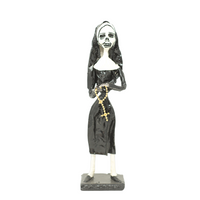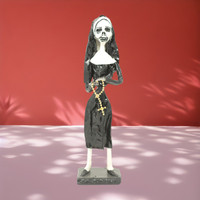
Handmade Mexican Folk Art, Day of the Dead Nun with Rosary Skeleton, Paper Mache Sculpture
Handmade Mexican Folk Art, Day of the Dead Nun with Rosary Skeleton, Paper Mache Sculpture 3"x3"x12"
November 2nd is the official date for Day of the Dead, although it is celebrated between October 31st and November 2nd. These dates correspond with the Catholic celebrations of All Saints Day and All Souls Day. This correspondence results from the Catholic Church's efforts to "find similarities between the indigenous and Christian beliefs." This celebration has a complex history that has been transformed through the years. Today the celebration takes place at about the same time ancient corn festivals were celebrated, when food from a plentiful harvest was shared with the deceased. Today different customs vary within different states in Mexico and even from village to village. The best way to describe this holiday is to say it is a time when family members and friends who have died are remembered. In Mexico, this festival is considered to be the most important holiday of the year.
El Día de los Muertos is not the Mexican version of Halloween as many consider it. It does share some similarities, among those costumes and parades; however, on Día de los Muertos it is believed that the border between the spirit world and the real-world dissolves. During this brief period, the souls of the dead awaken and return to the living to celebrate with loved ones. In turn, the family members treat the deceased as honored guests and bring along everything their loved one loved.
Día de los Muertos Symbols
Día de los Muertos is a day filled with symbols. Everything from the altar, to the ofrendas, the marigolds, and the alebrijes. But, out of the many symbols used during Día de los Muertos, the most popular by far are calacas (skeletons) and calaveras (skulls).
Paper Mache:
This skeletal figure is an example of contemporary folk sculpture that grew out of traditional toy making practices. For some generations the Linares family in Mexico City created papier mache toys for use in seasonal festivals such as Carnival, Holy Week, the Day of the Dead, and Christmas. In the mid-1950s Pedro Linares was introduced to the graphic work of the famous Mexican satirist, Jose Guadalupe Posada (1852-1913), who portrayed all aspects of Mexican society through a humorous guise of skeletons, or calaveras. Linares identified with Posada's ideas and began translating his images into three dimensional forms. With the help of his sons he started creating large calavera portraits of known political and social personalities to be blown up during Holy week or featured as sculptured decoration during the Day of the Dead festivities. The Linares family also started producing life-size multi-figured calavera groups portraying scenes from everyday life of Mexico in the late 20th century. One of their favorite subjects has been mariachi musicians. Here Pedro's second son, Felipe, has raised the craft of papier mache to the level of an ultimate art form with incredible detail in the shaping of the material as well as the decorative painting and added accessories.
Description
Handmade Mexican Folk Art, Day of the Dead Nun with Rosary Skeleton, Paper Mache Sculpture 3"x3"x12"
November 2nd is the official date for Day of the Dead, although it is celebrated between October 31st and November 2nd. These dates correspond with the Catholic celebrations of All Saints Day and All Souls Day. This correspondence results from the Catholic Church's efforts to "find similarities between the indigenous and Christian beliefs." This celebration has a complex history that has been transformed through the years. Today the celebration takes place at about the same time ancient corn festivals were celebrated, when food from a plentiful harvest was shared with the deceased. Today different customs vary within different states in Mexico and even from village to village. The best way to describe this holiday is to say it is a time when family members and friends who have died are remembered. In Mexico, this festival is considered to be the most important holiday of the year.
El Día de los Muertos is not the Mexican version of Halloween as many consider it. It does share some similarities, among those costumes and parades; however, on Día de los Muertos it is believed that the border between the spirit world and the real-world dissolves. During this brief period, the souls of the dead awaken and return to the living to celebrate with loved ones. In turn, the family members treat the deceased as honored guests and bring along everything their loved one loved.
Día de los Muertos Symbols
Día de los Muertos is a day filled with symbols. Everything from the altar, to the ofrendas, the marigolds, and the alebrijes. But, out of the many symbols used during Día de los Muertos, the most popular by far are calacas (skeletons) and calaveras (skulls).
Paper Mache:
This skeletal figure is an example of contemporary folk sculpture that grew out of traditional toy making practices. For some generations the Linares family in Mexico City created papier mache toys for use in seasonal festivals such as Carnival, Holy Week, the Day of the Dead, and Christmas. In the mid-1950s Pedro Linares was introduced to the graphic work of the famous Mexican satirist, Jose Guadalupe Posada (1852-1913), who portrayed all aspects of Mexican society through a humorous guise of skeletons, or calaveras. Linares identified with Posada's ideas and began translating his images into three dimensional forms. With the help of his sons he started creating large calavera portraits of known political and social personalities to be blown up during Holy week or featured as sculptured decoration during the Day of the Dead festivities. The Linares family also started producing life-size multi-figured calavera groups portraying scenes from everyday life of Mexico in the late 20th century. One of their favorite subjects has been mariachi musicians. Here Pedro's second son, Felipe, has raised the craft of papier mache to the level of an ultimate art form with incredible detail in the shaping of the material as well as the decorative painting and added accessories.












